Long ago someone put a shoulder stock on a handgun so he could do a better job of shooting it without becoming a skilled pistolero. The shoulder stock holds the gun steadier than the hands alone can hold it, thus some immediate handgunning success was possible. Some early examples were the shoulder-stocked Third Model Colt Dragoons and 1860 Army Colts of the Civil War era, and there were some earlier uses. We’ve seen examples of percussion firearms dating to the mid 1830s, and would bet a nickel there exist examples of shoulder-stocked flintlock pistols going back a hundred years earlier.
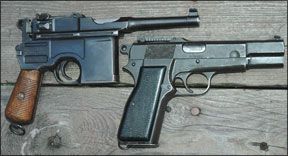
For this test report we looked at two guns from the early 20th century, both of which types saw plenty of wartime and civilian use. Our test guns are by Mauser and by Browning/Inglis. Both were supplied to us by Collectors Firearms in Houston. The Mauser was a C96 Model 1921 “Bolo” with short barrel ($2395 plus $395 for the stock at Collectors), and the Browning was a Hi-Power made by Inglis in Canada ($1650 with stock, also Collectors’s counter price). Both handguns had walnut stocks, and both had tangent sights with a narrow V-notch combined with a sharpened post front blade, which gave relatively poor sight pictures. We tested the 30 Mauser with Serbian Prvi Partizan FMJ ammo, and the 9mm Hi-Power with Black Hills 147-gr and Winchester BEB 115-gr ammunition. Here is what we found.
Oberndorf Mauser C96 1921 “Bolo” 7.63mm Mauser, $2395; Stock, $395
We got the gun and stock as a test package. Each came with a tag giving the description and condition, and we thought these were very accurate with one exception noted below. The Mauser’s stock was of workmanlike walnut with unremarkable grain. However, the stock appeared to have been refinished in the distant past. It had several repaired cracks, noted by the seller, and though the stock had enough room inside for the longer-barrel version of the Mauser 96, our test gun did not fit. We could not close the stock lid with the gun inside. The gun stuck somewhat, and we did not force it. A prospective buyer would have to be sure the gun and the stock were compatible before committing to purchase, we thought. In fact, we would not buy this stock with this gun.
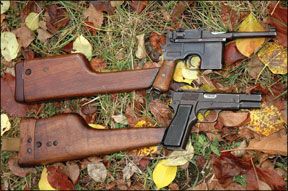
After some light cleaning of both surfaces, we were able to fit the stock tang into the recess on the back of the pistol’s handle. The fit was very snug, with no lost motion, unlike the fit of the Hi-Power to its stock, which permitted a good deal of sideways motion. We looked forward to shooting the package, but first we took a good look at the gun.
The 1896 Mauser was designed in 1895 by the Feederle brothers, one of whom (Fidel) was in charge of the experimental division of the Mauser factory. Ultimately over a million of these were made. W.D.M. Bell used a C96 Mauser on one of his first trips to Africa. He shot a hostile native’s spear in two, and then used the Mauser to scare off a whole gang of hostile natives who refused to allow his cattle to get water. He wrote of fitting the stock to the 10-shot Mauser as the natives watched and wondered, and then chased them to 500 yards with dust spurts from the gun.
Our example of this unusual “Broomhandle” pistol was a fine one, with the Mauser banner on the left side, six-digit serial number, small-ring hammer, and 10-round box magazine. The bluing appeared to be original, but we are not experts on the type. We’ve seen similar age-group M96s with no bluing on the hammer, bolt wing, or tangent sight base, but this one had bluing on all those surfaces. No matter, we thought this was as fine an example of the design as anyone short of a finicky WWI collector would ever want.
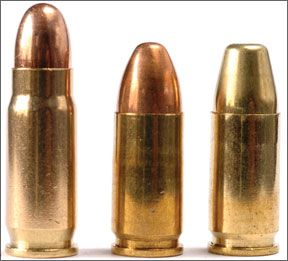
All the metal edges were almost as sharp as the day the gun was made. All the numbers, and there were a lot of numbered parts, matched. The stocks were walnut, and had two unexplained “notches” on the right side. The walnut stocks had 22 lines or grooves. The lanyard ring was intact. The gun had minor blemishes here and there, including a slight dent in the bottom of the magazine box, and some scratches on the rear grip strap. There was a slight amount of bluing wear on the forward corners of the protruding sides of the barrel assembly, where it wraps the receiver to form the sliding surfaces. The bottom front of the magazine box also showed a bit of wear. The rest of the gun was pretty much in what appeared to be original condition. We thought it was, for the most part, a thoroughly sound, well-preserved example of the “Bolo” or Model 1921 Mauser.
The seller declared the barrel to be excellent. We disagreed. The barrel had roughness near the sides of its grooves. The lands were clean, though not very prominent. All in all, the barrel seemed to be thoroughly useful, but we would have rated it no better than very good. The final test would be in how well it shot.
Taking the Broomhandle Mauser apart can lead to trouble if you’re not familiar with it. The takedown procedure is remarkably simple. With the gun unloaded and cleared, and with the bolt closed, remove the magazine follower, cock the hammer, and press upward on that little tab just under the hammer. The guts slide out the back, and that’s when the fun begins for the uninitiated. With the guts exposed, we pulled down on the hammer carrier. Out it came, and parts start to fall out. Happily, all the loose parts went back in only one way.
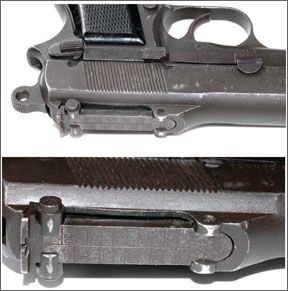
Every single part inside and outside the Bolo had been machined on every surface. The entire barrel assembly and the entire frame had been cut from solid blocks of steel. The machined leaf springs were held in place in recesses milled for them. There were lots of intricate parts inside this pistol. None of them were stampings. The mechanism was fascinating. We wondered why anyone would have designed a firearm in such a devious manner, but at the time, the dawn of autoloading pistols, many designs had the magazine in front of the trigger guard, and gun parts were all laboriously carved out of steel. All the parts inside looked excellent, with no traces of corrosion or significant wear. This was a sound pistol with all top-condition parts, we thought. We did not take all the parts out, but we examined them all.
Then came the fun of reassembling it. The two small parts that wanted to fall off were easily retained by our fingers. The big pivoting part (bolt locking block) went in first, and then the remainder of the trigger mechanism snapped in place into that. Then with the guts in place, the barrel/bolt/trigger assembly all slid back into the receiver and locked in place securely. All the parts interlocked. The only screw on the gun is that which holds the stock panels in place. Once the mechanism is understood, reassembly is easy. Without someone to show the way home, we recommend the novice not take this gun apart.
This was a complex, labor-intensive design. There was more machining done on just the bolt than on, say, an entire Glock pistol. The magazine follower was a masterpiece of carefully machined, polished steel. These Mausers were always rather expensive, and it’s easy to see why. The cost to make one today would be astronomical.
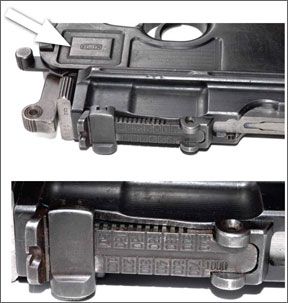
The Mauser was difficult to load without having any stripper clips on hand. The bolt locks back against the rear of the magazine follower, so once that’s depressed, the bolt goes forward. It was possible to lock the bolt rearward by use of a flat wood strip between the fully withdrawn bolt and part of the frame inside, and we were then able to load 10 rounds into the magazine. Even then, it was not easy. The rounds needed to be held in the middle of the opening, centered over the mag well, but once the first round was in, the supporting surface became slanted toward the rear, which mean the rounds didn’t want to stay in place and could not be easily pressed home. But we persisted, and with great care were able to load the gun for our testing. If you intend to own a Mauser 96, by all means get some stripper clips for it, or make a false clip to hold the bolt back. There were detachable magazines made for these guns, but they are rare today.
We used Serbian Prvi Partizan ammunition with a bullet of 85 grains. These gave a prominent muzzle flash along with a loud blast. We suspect the powder used would have been better suited for a longer barrel. The velocity was not what it should have been, and the gun felt too soft, we thought. Original loads had the bullet leaving the gun at around 1400-1450 fps. These loads got only 1060. We had on hand some ammunition intended for Tokarev pistols, and we found this similar ammunition came out of the “Tok” at around 1450 fps. That is the velocity the Mauser loads ought to have achieved, but didn’t.
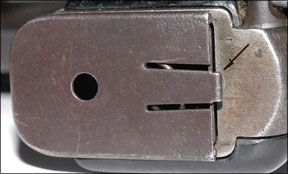
We expected better accuracy than we got, but we hasten to add we don’t know what it takes to make one of these Mausers shoot extremely well. The gun was well fitted, the barrel was linked solidly to the sights, there was no looseness to the gun, and we thought it ought to have shot much better than it did. Our groups were all around 2.5 inches for five shots at 15 yards. We believe the condition of the barrel was the cause for the relative inaccuracy.
The recoil of the high-barrel Mauser was not sharp, but did cause the gun’s muzzle to flip noticeably. We expect the few examples chambered for 45 ACP would be a real handful. The flip was reduced drastically when firing the gun with the stock attached. Our groups didn’t improve nor degrade to any significant extent with the stock on or off. This was true for both test guns. However, the impact point changed with the Mauser from about five inches high when hand held to 2.5 inches high, stocked. The smooth surface of the stock’s butt wanted to slide off our shoulder. All in all we didn’t like shooting the gun with the stock attached, but realize it’s part of the Broomhandle’s charm.
Our Team Said: We enjoyed examining this Mauser for its design features and its great novelty. We all thought the Mauser ought to have been a tack driver, but it was not, and that was disappointing. Maybe a different load would work magic. However, we thought the Bolo Mauser, or any of the C96s, would give the buyer a great look at how guns were made long ago and far away. This was the first successful autoloading pistol design, and won’t ever be made again. By the way, the gun was not the least bit clumsy, we thought. They are lots of fun to own and shoot. We gave the gun an A grade, but rated the stock a C, and would not buy one unless the gun fit inside properly.
Inglis Hi-Power w/Stock 9mm, $1650
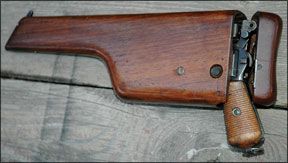
This gun appeared to have been a wartime manufacture. Its exterior surface had never been finely polished, and the Parkerizing showed blemishes here and there. The edges were all free of finish, yet still relatively sharp. The grip panels were black checkered plastic. The left side of the grip had a lanyard ring at the bottom. The tangent sight’s “ladder” had mottled bluing or Parkerizing on it, making it hard to read. The magazine had a spring clip formed into its bottom to make it easier to get it apart for cleaning. We had to clean out some grit and grease before loading it, and then found its spring was too weak to permit reliable feeding. We used a commercial magazine for our tests.
The Canadian-made stock for the Hi-Power was carved out of lovely figured walnut. It was dated 1945 and marked “Made in Canada.” It also had a spring clip and a short strap for securing it to a pistol belt. The gun fit it perfectly, and the lid kept the gun from rattling by means of a spring that pressed against the rear grip strap. The designs of the Mauser and Hi-Power stocks were nearly identical. However, the butt portion of the Hi-Power’s stock was larger and more curved, and tended to stay on the shoulder much better than that of the Mauser. But the stock fit the gun loosely. The gun could shake a degree or two sideways, though it was held very securely to the stock.
Takedown was just like any Hi-Power, though the recoil spring was a good deal stiffer than one on a commercial Hi-Power on hand. The barrel was in very good condition on the inside, as was the entire gun, we thought. The fit of the slide to the receiver was on the loose side, excellent for military reliability but not so good if you want a tack driver. The same was true of the fit of the barrel to the slide. We were not expecting outstanding accuracy, nor were we disappointed.
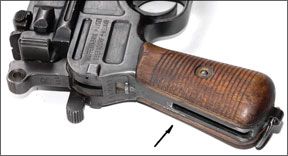
On reassembling the Hi-Power we gathered up the loose-fitting but gorgeous stock and took it and the gun to the range. We first tried 147-gr Black Hills FMJ and got mediocre groups, with and without the stock. The impact point didn’t change much with the addition of the stock. The shots landed 4 inches low and about 2 inches to the right with the tangent sight at its lowest setting. We then tried the Winchester BEB 115-gr fodder and it did about as well, which is to say groups in the 3- to 4-inch range at 15 yards. Our best group was 2 inches with the 147-gr ball, without the stock. We then tried pressing the gun to the side to minimize the looseness of the stock and fired one group of 1.7 inches with the 115-gr ammo, but then we fired several more a good deal larger. We concluded the stock was not helpful to trained shooters at combat ranges, but might be valuable for area fire at extended ranges. The tangent sight had markings to 500 yards. The Mauser’s went to 1000 yards.
For a collector or student, we thought the Mauser C96 was much the more interesting of these two, and its price reflected that. It was the first example we’ve examined, and we thought it was amazing. We’ve seen many Hi-Powers, so there was not a lot new there for us. But for any student of firearms, there’s a lot of history contained in either of them. As one example of the early design of the Hi-Power, its extractor came through from the back of the slide, much like that on the 1911 45 auto. Later designs place the extractor into a notch on the side of the slide. Its front sight is dovetailed in, and staked in place. You may have thought that was a recent innovation. The little things make these older guns fascinating.
Our Team Said: We concluded the Inglis was an excellent example of a war-issue Hi-Power, and its stock made it that much more desirable. The magazine spring could be replaced easily, which would fix the feeding problem. A commercial magazine worked perfectly. Despite its non-target accuracy (the Mauser shot better, overall), we gave this Hi-Power collector’s setup an A grade. The price, we thought, was reasonable for one of these increasingly scarce, wood-stocked Hi-Powers. If you want a gun that will make smaller groups there are better choices, but if you must have one of the stocked wartime Hi-Powers, in all original military condition, with matching numbers, we thought this one was a fine example for a reasonable price.





























